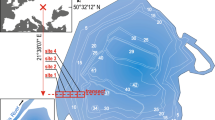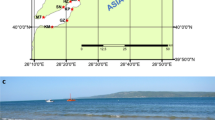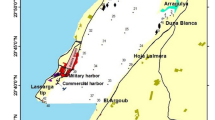Abstract
The biological effects of a low-volume domestic sewage discharge were studied near Wilson Cove, San Clemente Island, California (USA), from February to June, 1972. There were fewer species and less cover near the outfall (7 macro-invertebrates, 17.6%; 13 macrophytes, 91.7%) than in nearby “unpolluted” control areas (9 macroinvertebrates, 9.2%; 30 macrophytes, 103.4%). The outfall biota was less diverse than that of the controls, as shown by 5 different diversity indices. A great reduction in community stratification (spatial heterogeneity) and, hence, community complexity occurred near the outfall; this reduction in stratification was primarilly due to the absence of Egregia laevigata, Halidrys dioica, Sargassum agardhianum and Phyllospadix torreyi. These were replaced in the mid-intertidal near the outfall by a low turf of blue-green algae, Ulva californica, Gelidium pusillum and small Pterocladia capillacea, and in the lower intertidal by Serpulorbis squamigerus covered with Corallina officinalis Var. chilensis. A statistically-based determination of assemblages or groups of organisms (i.e., cluster analysis) revealed 3 discrete outfall and 3 discrete control area groups; 3 assemblages contained samples from both areas. The distributional patterns of these groups indicate that near the outfall the degree of dilution of discharged sewage is more important in regulating zonation than is tidal height. The enhancement of the suspension feeder Serpulorbis squamigerus and the omnivores Ligia occidentalis, Pachygrapsus crassipes and Anthopleura elegantissima in the outer fringe of the outfall plume hypothetically is due to their ability to utilize sewage as a food source. A critical effect of the outfall may be to decrease environmental stability thereby favoring rapid-colonizers and more sewage-tolerant organisms. The outfall macrophytes were characterized by relatively higher net primary productivities, smaller growth forms, simpler and shorter life histories, and most were components of early successional stages.
Similar content being viewed by others
Literature Cited
Bandy, O.L., J.K. Ingle and J.M. Resig: Foraminiferal trends, Laguna Beach outfall area, California. Limnol. Oceanogr. 9, 112–137 (1964)
Bechtel, T.J. and B.J. Copeland: Fish species siversity indices as indicators of pollution in Galveston Bay, Texas. Contr. mar. Sci. Univ. Tex. 15, 103–132 (1970)
Borowitzka, M.A.: Intertidal algal species diversity and the effect of pollution. Aust. J. mar. Freshwat. Res. 23, 73–84 (1972)
Brillouin, L.: Science and information theory, 351 pp. New York: Academic Press 1956
Chapman, A.R.O.: A critique of prevailing attitudes towards the control of seaweed zonation on the sea shore. Botanica mar. 16, 80–82 (1973)
Connell, J.H.: Effect of competition, predation by Thais lapillus, and other factors on natural populations of the barnacle Balanus balanoides. Ecol. Monogr. 31, 61–104 (1961a)
—: The influence of interspecific competition and other factors on the distribution of the barnacle Chthamalus stellatus. Ecology 42, 710–723 (1961b)
—: A predator-prey system in the marine intertidal region. I. Balanus glandula and several predatory species of Thais. Ecol. Monogr. 40, 49–78 (1970)
—: Community interactions on marine rocky intertidal shores. A. Rev. Ecol. Syst. 3, 169–192 (1972)
Dayton, P.K.: Competition, disturbance, and community organization: the provision and subsequent utilization of space in a rocky intertidal community. Ecol. Monogr. 41, 351–389 (1971)
—: Two cases of resource partitioning in an intertidal community: making the right prediction for the wrong reason. Am. Nat. 107, 262–270 (1973)
Dawson, E.Y.: A primary report on the benthic marine flora of Southern California. In: An oceanographic and biological survey of the continental shelf area of Southern California. Publs Calif. St. Wat. Pollut. Control Bd 20, 169–264 (1959)
Dawson, E.Y.: Chapter 8. Intertidal algae. In: An oceanographic and biological survey of the Southern California mainland shelf. Publs Calif. St. Wat. Qual. Control Bd 27, 220–231, 351–438 (1965)
Doty, M.S.: Rocky intertidal surfaces: In: Treatise on marine ecology and paleoecology. Vol. 1. Ecology, pp 535–585. Ed. by J.W. Hedgepeth. New York: Geological Society of America 1957. (Mem. geol. Soc. Am., No. 67)
Fahey, E.M.: The repopulation of intertidal transects. Rhodora 55, 102–108 (1953)
Golubic, S.: Effect of organic pollution on benthic communities. Mar. Pollut. Bull. 1, 56–57 (1970)
Jones, D.J.: Variation in the trophic structure and species composition of some invertebrate communities in polluted kelp forests in the North Sea. Mar. Biol. 20, 351–365 (1973)
Kenis, P.R., M.H. Salazar and J.A. Tritschler: Environmental study of the sewage outfall area of San Clemente Island. Tech. Pap. nav. Undersea Res. Dev. Center, S. Diego (NUC TP) 292, 1–36 (1972)
Littler, M.M.: Standing stock measurements of crustose coralline algae (Rhodophyta) and other saxicolous organisms. J. exp. mar. Biol. Ecol. 6, 91–99 (1971)
Littler, M.M.: The relationship between thallus form and the primary productivity of seaweeds. Proc. 8th Int. Seaweed Symp. London: Academic Press (In press)
— and S.N. Murray: The primary productivity of marine macrophytes from a rocky intertidal community. Mar. Biol. 27, 131–135 (1974)
Margalef, R.: On certain unifying principles in ecology. Am. Nat. 97, 357–374 (1963)
—: Diversity and stability: a practical proposal and a model of interdependence. Brookhaven Symp. Biol. 22, 25–37 (1969)
Menge, B.A.: Competition for food between two intertidal starfish species and its effect on body size and feeding. Ecology 53, 635–644 (1972)
Nicholson, N.: The Santa Barbara oil spills in perspective. CalCOFI Rep. 16, 130–149 (1972)
— and R.L. Cimberg: The Santa Barbara oil spills of 1969: a post-spill survey of the rocky intertidal In: Biological and oceanographical survey of the Santa Barbara Channel oil spill 1969–1970, Vol. 1. pp 325–399. Ed. by D. Straughan. Los Angeles: A. Hancock Foundation, University of Southern California 1971
North, W.J.: Ecology of the rocky nearshore environment in Southern California and possible influence of discharged wastes. Proc. lst int. Conf. Wat. Pollut. Res. 3, 247–262 (1964)
North, W.J., G.C. Stephens and B.B. North: Marine algae and their relations to pollution problems. Proc. F.A.O. tech. Conf. mar. Pollut. MP/70/R-8, 1–22 (1972)
Odum, E.P.: The strategy of ecosystem development. Science, N.Y., 164, 262–270 (1969)
Paine, R.T.: Food web complexity and species diversity. Am. Nat. 100, 65–75 (1966)
—: A short-term experimental investigation of resource partitioning in a new Zealand rocky intertidal habitat. Ecology 52, 1096–1106 (1971)
Pianka, E.R.: On r- and K- selection. Am. Nat. 104, 592–597 (1970)
Pielou, E.C.: An introduction to mathematical ecology, 286 pp. New York: Wiley-Interscience 1969
Regier, H.A. and E.B. Cowell: Applications of ecosystem theory, succession, diversity, stability, stress and conservation. Biol. Conserv. 4, 83–88 (1972)
Shannon, C.E. and W. Weaver: The mathematical theory of communication, 117 pp. Urbana: University of Illinois Press 1949
Simpson, E.H.: Measurement of diversity. Nature, Lond. 153, p. 688 (1949)
Sokal, R.R. and P.H.A. Sneath: Principles of numerical taxonomy, 359 pp. San Francisco: W.H. Freeman & Co. 1963
State Water Quality Control Board (California): An investigation on the fate of organic and inorganic wastes discharged into the marine environment and their effects on biological productivity. Publs Calif. St. Wat. Qual. Control Bd 29, 1–116 (1965)
Storrs, P.N., E.A. Pearson, H.F. Ludwig, R. Walsh and E.J. Stann: Estuarine water quality and biological population indices. In: Advances in water pollution research pp 901–910. Ed. by S.J. Jenkins. London: Pergamon Press 1969
Widdowson, T.B.: Changes in the intertidal algal flora of the Los Angeles area since the survey of E. Yale Dawson in 1956–1959. Bull. Sth. Calif. Acad. Sci. 70, 2–16 (1971)
Zaneveld, J.S.: Factors controlling the delimitation of littoral benthic marine algal zonation. Am. Zool. 9, 367–391 (1969)
Author information
Authors and Affiliations
Additional information
Communicated by J.S. Pearse, Santa Cruz
Rights and permissions
About this article
Cite this article
Littler, M.M., Murray, S.N. Impact of sewage on the distribution, abundance and community structure of rocky intertidal macro-organisms. Marine Biology 30, 277–291 (1975). https://doi.org/10.1007/BF00390633
Accepted:
Issue Date:
DOI: https://doi.org/10.1007/BF00390633




